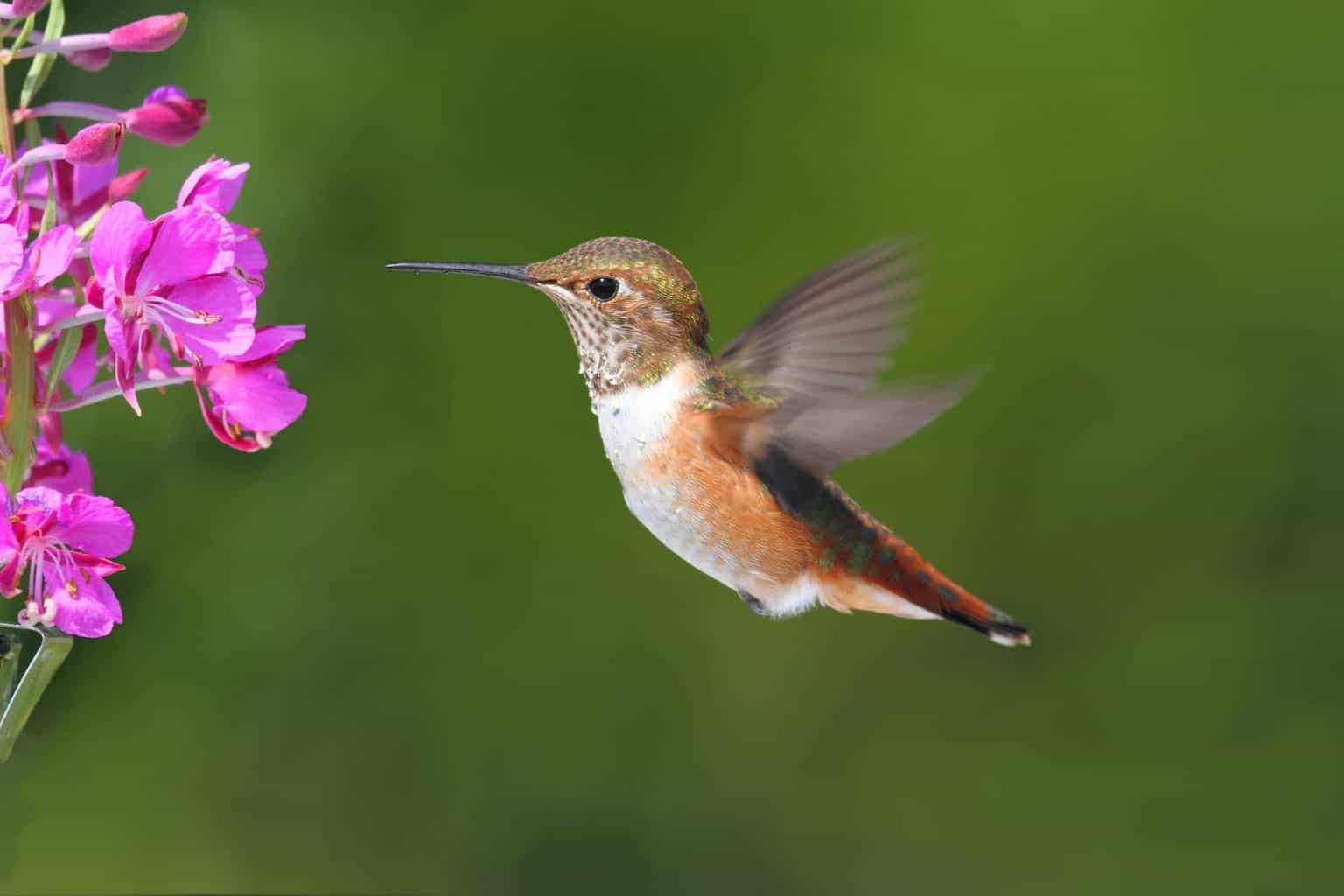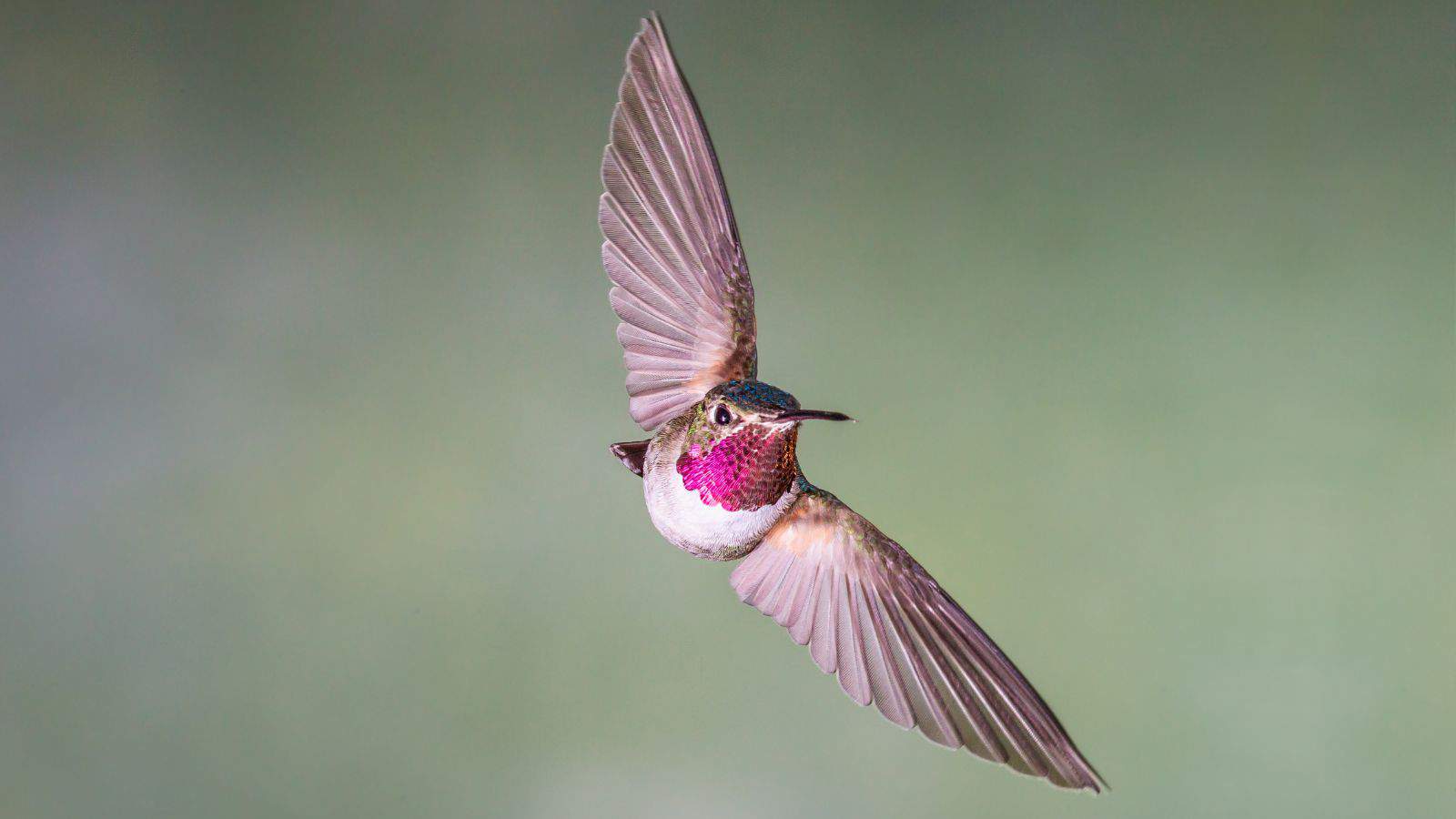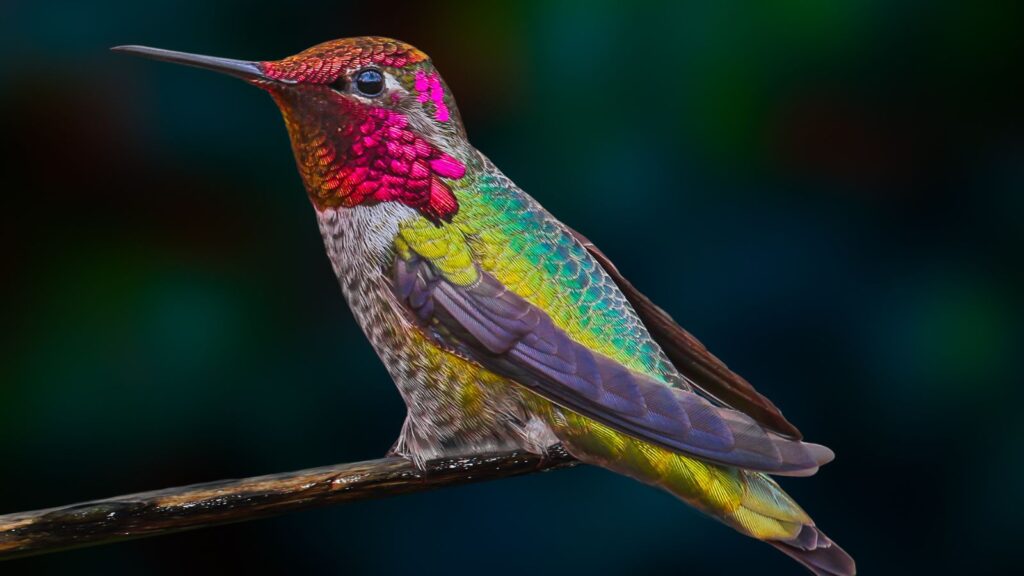The avian world is full of variety in shapes and color, and in no group of birds is that more evident than the hummingbird family, Trochilidae.
There are about 350 species of hummingbirds recorded, the majority of which are native to Central and South America. They are tiny little birds measuring just a couple of inches apiece, with long, thin bills used to drink the nectar of deep flowers.
In addition to these incredible features, many hummingbird species sport bright hues of purple, orange, red, blue, and green.
Understanding Hummingbird Colors
For the sake of brevity, we won’t discuss the colors of every single hummingbird in this article, but let’s take a quick look at some of each color, with a slight focus on North American species where applicable.
Green
Green is one of the most common colors to see in a hummingbird, and it’s sometimes the only flashy color for females that lack the males’ bright gorget colors.
The gorget is a colorful, flashy patch of feathers around the collar area, named for an old piece of armor that was traditionally worn to protect the neck in battle. Male hummingbirds use it to impress potential mates, which don’t feature the colorful gorget.
Take the ruby-throated hummingbird, for example. The only resident hummingbird in eastern North America, females lack the namesake ruby throat of the males. Their undersides are white with a metallic green back. Males are also green on their backs.

Anna’s hummingbird, a resident of the coastal Pacific states, and the western North American broad-tailed hummingbird also feature flashy green colors, among many others.
Blue
Arguably the most brilliant blue hummingbird is the blue-chested hummingbird, native to Central America. The bee hummingbird, a blue hummer endemic to Cuba, is the smallest bird in the world.

In North America, the broad-billed hummingbird is the most notably blue, although the blue-throated mountain-gem of Mexico and the U.S. Southwest features a standout gorget that is a beautiful blue hue.
Purple

Male Costa’s hummingbirds, most prominent in California and Baja California, feature famously purple gorgets, which play a huge part in their unique mating rituals.
Male black-chinned hummingbirds, common throughout the West up to the Canadian border and south into Mexico, have purple gorgets as well, as does the Lucifer hummingbird, mostly seen in Mexico.
We would be remiss if we did not also mention Central America’s incredible violet sabrewing, which is a beautiful purple color.
Orange

The rufous hummingbird and Allens’ hummingbird are North America’s resident orange hummingbirds.
Rufous hummingbirds have a breeding range that stretches from southwestern Alaska down to the southern edge of Oregon and inland to parts of Idaho and Montana.
Males are mostly bright orange across their backs, while females are mostly white on their undersides with a greenish tint to their backs. They have some orange along their sides as though they were just starting to rust.
Allen’s hummingbirds are breeders native to the Pacific coasts of California and Oregon, where they stand out with their brilliant orange and green colors, including the male’s flashy orange gorget.
The ruby-throated hummingbird’s bright gorget can sometimes appear orange in certain lighting.
Red

The most notable red color on a North American hummer is the broad-tailed hummingbird’s sharp red gorget.
Broad-tailed hummingbirds are residents of Mexico and the United States’ mountain states.
Pink

Pink is not the most common color for hummingbirds, but several hummingbirds do have pink gorgets, including South America’s wine-throated hummingbird and bumblebee hummingbird.
Another notable North American species is the calliope hummingbird, a beautiful hummingbird that has a vertically streaky gorget from the bill across the throat. Calliope hummingbirds reside across scattered parts of the West.
White

Many hummingbirds have white – or at least pale – undersides. Some are bigger (and whiter) than others, and they’re not usually the bird’s most prominent color.
Seeing a pure white hummingbird isn’t impossible. If you do see one, there’s a pretty good chance it’s either albino or leucistic, meaning the bird has either a full or partial loss of pigment. Both are uncommon, but albinism is particularly rare.
Are All Hummingbirds Colorful?
Not all hummingbirds have vibrant colors. Females especially lack the flare of males in many cases, but there are also hummingbird species that are more inconspicuous in both sexes.
Several hermit species of Central America and South America, including the buff-bellied hermit and streak-throated hermit, sport browns, grays, and other drab colors less frequently associated with hummingbirds.
And not every species of hummingbird has a gorget – consider some hermit species from South and Central America. The males lack the colorful throats so commonly associated with this bird family.
The Rarest Hummingbird Colors

We’ve touched on nearly the entire rainbow, but one noticeably absent color is yellow.
Green, blue, purple, and orange are common hummingbird colors, including gorgets and other plumage, but you won’t find much for yellow hummingbirds.
Parts of some, like South America’s copper-tailed hummingbird, may appear yellowish in certain light, and the ruby-topaz hummingbird has a yellow gorget, but yellow is not a super common color in hummingbirds.
Black is also fairly uncommon, although certain lighting can cause even the most brilliant of birds to appear dark.
Gender Differences in Hummingbird Colors
Many types of birds have differences between males’ and females’ color patterns, and hummingbirds are no exception. While they may be small, a good look at one and its sex will be evident.
The male hummingbird’s gorget, used to impress potential mates during mating displays, is the most obvious difference, as females won’t have the shiny throat patch that is commonly associated with hummers like the ruby-throated hummingbird.
That’s not all that may be missing from female hummingbirds, however. Many species’ females don’t have the male’s flair – take the Rivoli’s hummingbird for example – the male has a dark chest and wings and a purple head to go with its brilliant aqua-colored gorget. Females, meanwhile, have green backs and light undersides – par for the course among female hummingbirds.
In others, the difference is less pronounced but still evident, such as Allen’s hummingbird as discussed earlier. Males are mostly orange with green-tinged backs and a brilliant orange gorget. Females and immature males have a very similar pattern to males but with significantly muted colors.
While they may not be as flashy as males, female hummingbirds are still quite striking. Let’s dive into that.
Female Hummingbirds: More Than Meets the Eye
No gorget aside, female hummingbirds still catch the eye immediately when they buzz by.
The ruby-throated hummingbird female, for example, is a metallic green color. Other females would be considered colorful were it not for their corresponding male’s colors. The broad-billed hummingbird female is a mix of green and pale with an ocean-blue underside to its tail, not to be overshadowed by the male’s greens and blues.
And the broad-tailed hummingbird’s wide tail of segmented brown, black, and white is not to be missed.
Some hummingbird males and females look the same, like the violet-crowned hummingbird, a resident of parts of Mexico and southeastern Arizona.
The animal world is full of variety, adaptions, and evolutions. That includes the color patterns of male and female white-necked jacobins, a species of South American hummingbird.
A study published in Current Biologyin 2021 found that about 30 percent of female white-necked jacobins look like males and therefore receive less social harassment than other males.
Hummingbird individuals can be aggressive toward one another, so being perceived as a male may keep some females from being harassed.
In an interview with CBC Radio’s As it Happens, researcher Jay Falk said that the more colorful females were still able to find mates even though they were less attractive to males than the more traditionally patterned females.
It’s not known why some females develop bright coloring like males and others don’t, but it could be an evolutionary change to avoid harassment from males, although it does present some negatives in terms of mate selection and detection by predators, as more subdued females are less likely to stand out.
How Male Hummingbirds Stand Out
As you’ve seen in a couple of the videos included so far, male hummingbirds perform fascinating mating displays, in which their colors play a central role.
In this video, you can see how the male hummingbird uses its flashy gorget, circling the potential mate while showing off its colors.
A lot goes into a male’s display, including speed. University of California, Riverside researchers found that Costa’s hummingbirds alter their trajectory to minimize their Doppler sound, meaning females are less likely to accurately track the male’s speed and they might seem faster than they actually are.
Costa’s hummingbirds have one of the most fascinating mating displays in the Avian world, as shown in the PBS Nature clip from earlier in the article.
The Meaning of Hummingbird Colors
Hummingbird gorgets can also be used by males to stake their territory. Despite their small stature, they can be very territorial birds.
Displaying their gorget in an aggressive manner where it catches the light the right way makes the reds, pinks, purples, or other colors of the hummingbird’s gorget really stand out.
Despite little to no overlap in the species’ ranges, male black-chinned and ruby-throated hummingbirds can often be confused because the male ruby-throat isn’t flashing its gorget in the right direction, the U.S. Forest Service states.
Misconceptions About Hummingbird Colors
Hummingbird Food Coloring
The hummingbird’s flashy plumage colors aren’t the only colors that often come up in regard to hummingbirds. The hottest topic in the hummingbird world is arguably the topic of red food coloring in hummingbird food and whether it’s necessary or safe.
Homemade and store-bought nectar has long been colored red, a color that is said to attract hummingbirds, but lately, the trend has shifted away from using dyes in hummingbird nectar.
Red 40, a common dye used in the United States, is banned in some European countries, and although there haven’t been scientific studies to prove it, some people believe it could be harmful to hummingbirds.
At best, most agree that it’s unnecessary. Actual flower nectar isn’t red and hummingbird feeders are usually red and yellow or other bright colors to attract hummingbirds anyway.
Do Hummingbirds Have Good Vision?
Hummingbirds have amazing vision with the ability to perceive colors beyond what the human eye can detect. According to a study from researchers at Princeton University, the University of British Columbia, Harvard University, the University of Maryland, and the Rocky Mountain Biological Laboratory, most bird species have four color cone types, which allow them to see nonspectral ultraviolet colors.
The ability to see non-spectral colors likely spreads across the animal kingdom, researchers stated, but hummingbirds were ideal to study how birds use color every day in search of food since they use color to find flowers and nectar.
More To Explore
Hummingbirds are fascinating birds with as wide a range of colors as any family on Earth, and that’s far from the only interesting thing about them.
With their diminutive size, secretive nesting habits, and typically short time in North America each year, they’re sure to be a curiosity for many birders. That can lead to a lot of questions, such as:
When do they leave and arrive each year?
What other birds (or bugs!) look like hummingbirds?
For the answers to these questions and more, click here.
Frequently Asked Questions
Is There a Rainbow Hummingbird?
The rainbow starfrontlet is native to Ecuador and Peru, where it has six subspecies in a rather small range, providing an example of the incredible variety in South America’s hummingbirds.
How Many Hummingbird Species Are There?
There are 349 species of hummingbird across 107 genera, according to the Cornell Lab of Ornithology’s All About Birds.
Of these 349, all are New World Species but only about a dozen are found in any part of the United States or Canada. Central and South America are the world’s hummingbird hotbeds.

